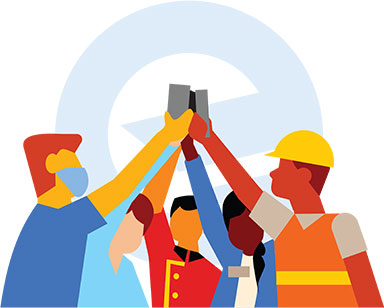While many executives work from an office setting, most of their employees are on the ground floor. In the workforce, these team members are considered “non-desk” or “deskless” workers – those who don’t sit in front of a computer to do their job, don’t have corporate email inboxes, and often have a different set of needs, values, and work patterns than their desk-based counterparts.
Despite making up 80 percent of the world’s workforce, these deskless workers have largely gone overlooked and ignored, which can clearly be seen by the lack of tools they have to effectively communicate and perform their jobs at the highest level. What many company leaders may not realize is that continuing to turn a blind eye to these unique set of needs and behaviors has a major impact on all things that affect the bottom line, including employee engagement, turnover, and productivity. Gaining a better understanding of the non-desk workforce can help improve each of those things, and fortunately, there’s no better time to do just that than now.
As the pandemic shines a light on the importance of deskless workers in keeping businesses, and the overall economy going, it has also given us a window into how these workers operate – who they are, how they behave, and what matters most to them. By truly understanding what makes these workers tick, employers have a real opportunity to meet their unique needs and arm them with the proper tools that maximize performance, productivity, and output.
As a leader, here are the top five things you should know about your non-desk workforce:
1. Your deskless workers are (often) the face of your brand.
“Frontline,” says it all. Many of these workers literally represent your company, your services, and perhaps most importantly, your brand. Day in and day out, they are running the business and interacting directly with customers, patients, and products. In many cases, they build relationships, knowing everything about those they serve, and they are often the difference between a good and bad customer experience. This has major trickle-down implications when it comes to word-of-mouth, as well as customer response and retention. Embracing these workers by keeping them in the know not only gives you insight into your customers but can also have a major impact on customer experience – hitting you right on the bottom line.
2. It’s not just your customers who are online, it’s your employees too.
The world is turning mobile, and as a leader of deskless workers, it is important to remember that your customers are not the only ones doing everything online. Your employees are doing everything online too. The vast majority of non-desk workers rely exclusively on their mobile devices for their connection to the internet. It’s how they get their news, listen to music, and even how they read and watch movies, so it would make sense that it is also how they communicate for their job. In order to effectively engage with these workers, it is important to meet them where they are and connect in the ways that matter most to them.
3. Your team members want to feel valued and engaged.
Employee engagement is a key ingredient of any business, as it has direct ties to productivity, satisfaction, retention, and your bottom line.
For example, in the restaurant business, employee engagement – whether that’s a smiling face at the door or someone that will go the extra mile to make sure the order is correct – can be the difference between customers coming back for more or never returning again.
One study shows that 95 percent of guests would go back to a restaurant again if they had a pleasant experience and the staff catered specifically to their personal preferences. This kind of customer service can only happen if employees feel fulfilled, happy, valued, and important at work. To ensure employees feel this way, it is important to keep them in the loop on all company communications, updates, and goals. Few things discourage an employee like making them feel like they are the last to know about important company news. Properly communicating your business’ core philosophy and mission helps promote a sense of team spirit and keeps everyone focused on a common goal.
4. They also want to be recognized, supported, and given growth opportunities, especially since they often feel disconnected.
Employee retention is a major challenge for companies that rely on a primarily hourly workforce. Some of the main contributors to a high turnover rate include the lack of support, recognition, and growth opportunities that are often provided to employees in the non-desk workforce.
These deskless workers need coaching and training to do their job right, and they typically receive a healthy dose of that instruction during the onboarding process. Unfortunately, they don’t always get the ongoing support and development that their desk-based counterparts receive. Growth opportunities are important for your workers to grow professionally. Leveraging technology that aligns with how they learn and creating training programs that support their development can help fix this problem.
5. They need to have the latest information.
The non-desk workplace is typically a fast-paced environment overloaded with information, requiring all levels of management to be effective and efficient in the way they communicate with their frontline employees. Now, more than ever, it is essential that leaders provide their employees with the latest information, not only to keep them up-to-date but also to keep them safe. Leaders should seek to eliminate unnecessary noise and simplify access to information so that important messages do not get buried.
For leaders, all of this means that connecting the disconnected, deskless workforce can have a major impact on all things that affect the bottom line. Internal communication KPIs are tightly connected to all other KPIs at your organization – from customer experience, to quality, to sales. Begin by understanding that your non-desk workforce has a different set of needs, access, and work patterns, and evaluate your communication strategy based on your new perspective.


